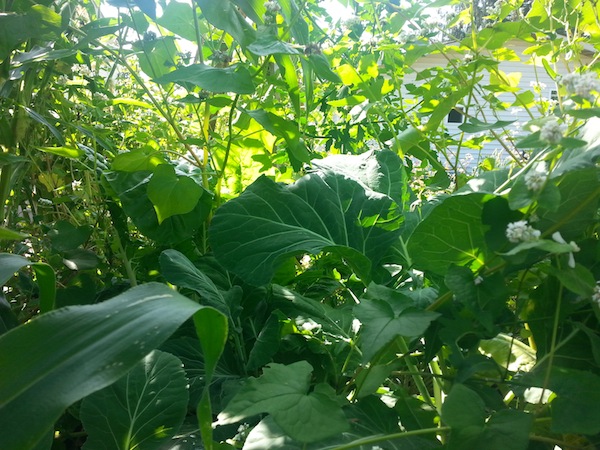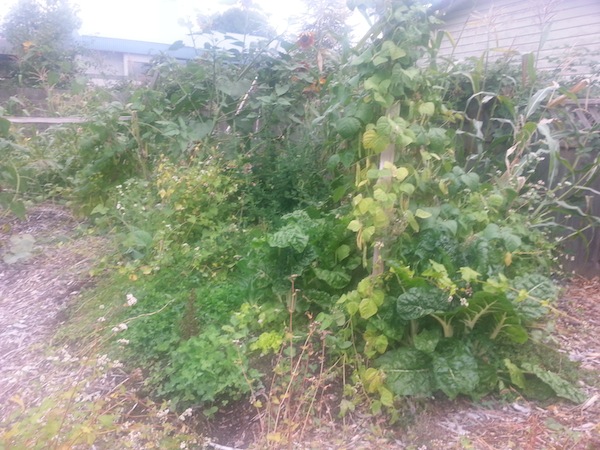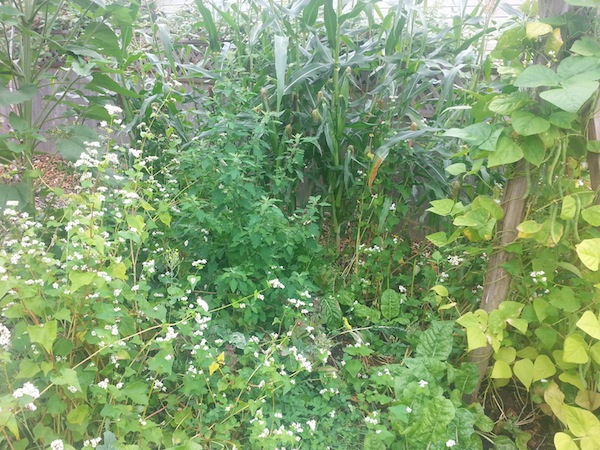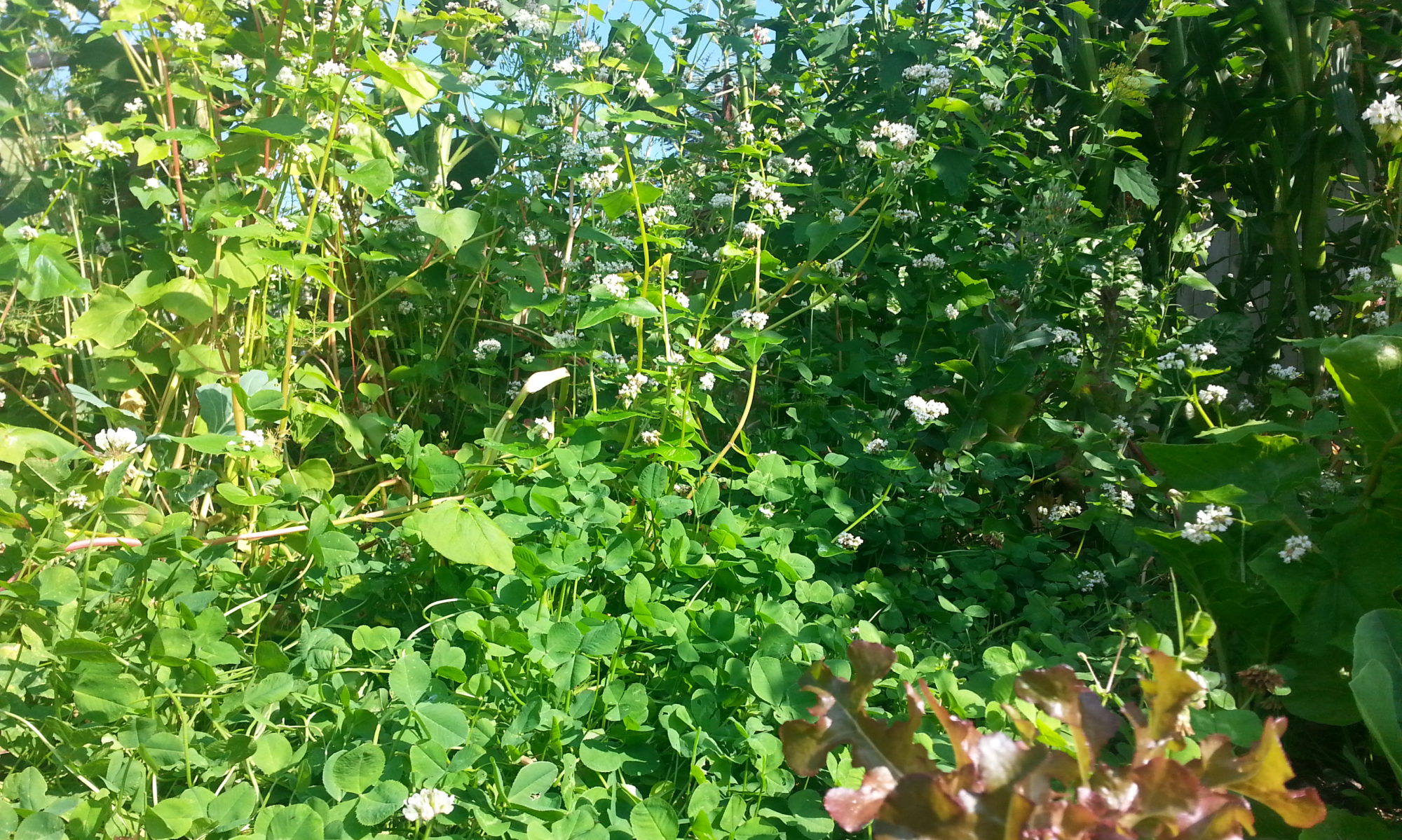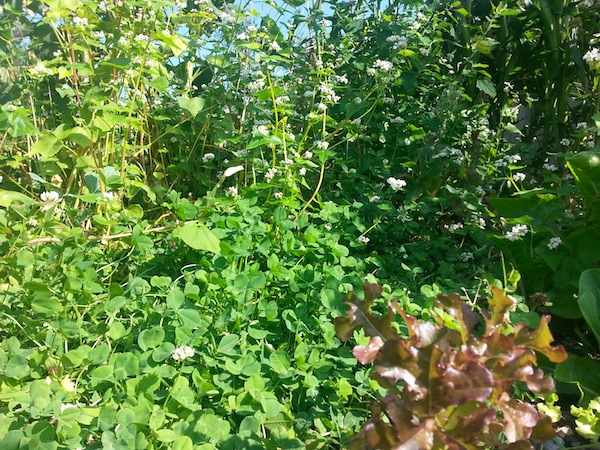
Mixed canopy
Canopy means cover. In a garden (or a forest, or a forest garden) plants are the cover. A “mixed canopy” garden means that the garden is covered (canopied) with a mix of plants, ie – plants that vary in height, density, species, maturity etc.
Polyculture
Poly = many.
Culture = tend, grow, cultivate.
Polyculture in a gardening context means the growth, tending, or cultivating of many types of plants. This can perhaps be understood most clearly in contrast to its opposite: monoculture.
A monoculture is the growth or cultivation of a single species at the exclusion of all others. Most industrial agriculture is monoculture; a single crop is sown, tended, and harvested on a single timeline. All other plants (in fact oftentimes virtually all other life forms) are unwelcome and are treated as enemies.
A polyculture is the simultaneous growth or cultivation of many species. Sowing, tending, and harvesting happens on complex, intersecting timelines, not on a single timeline.
Mixed canopy polyculture and food forest gardening
In a mixed canopy polyculture like the one in the Food Forest Garden at Munson Manor, plants of many different types, at many different stages of maturity, are grown simultaneously in close relationship.
The canopy – the cover or top layer of the garden/forest/living system – is mixed; it is of mixed height, mixed type, mixed age, mixed density, mixed function etc. Trees, shrubs, various perennials, groundcovers, herbs, and annual vegetables all form this canopy at different times or stages and in different locations in the garden.
This type of design is quite different from the monoculture model, and it comes with certain characteristics, especially the characteristic of diversity. By definition, mixed canopy polycultures are more diverse than their mono counterparts. This diversity includes the cultivated plant species, but may also include weedy volunteer plants as well as insect and animal life.
The diversity of a mixed canopy polyculture extends beyond species and includes diverse harvests/yields/crops, diverse management tasks and techniques, diverse timelines, and diverse form and aesthetics.
Other characteristics are also implied –
- Bare soil is minimized
- The form and function of the garden is dynamic and evolving
- Water requirements are relatively low
- Hand-based management is more appropriate than machine work
- Biomass is high
- Fertility is maintained on-site with few or no inputs
- On-site propagation (including seed-saving) is practical
- Microclimates are created
- Resiliency
Like most backyard gardeners, we dedicate a few beds to annual (or biennial) vegetables each year. Even these beds have a small-scale mixed canopy polyculture look and feel. Last year’s six foot tall flowering kale provides dappled shade for baby summer lettuces. A tangle of seeding corn salad (mache) mulches the young cabbage plants until the seed is ripe and harvested. Weeds like chickweed, lambsquarters, and purslane provide dense edible groundcover that keeps the soil protected and friable until we want to plant something there. This kind of complex and semi-improvised cross-succession of weeding, planting and harvesting unfolds throughout the season, maximizing diversity, interest, beauty, fertility, yield, and delight.
Mixed canopy polyculture looks a lot different from how many folks expect a garden to look. Chaotic, messy, overgrown, and weedy are all descriptors that we’ve heard from the uninitiated.
Sometimes half a dozen different edible plants can be found within a square foot; garlic interplanted with lettuce, fava beans, arugula, and giant cress; corn with cucumbers and buckwheat twisting up the stalks and swiss chard and potatoes peeking out at the edges; tall collards and dill stacked over parsley, lettuce, bush beans and edible violets (aka Johny-jump-ups).
Many of our guests don’t know what to make of our food forest garden. They have no context for understanding it, no conceptual box that it fits into; they really don’t know what they are looking at!
The other day Sue was in the front yard harvesting raspberry leaves for tea. A neighbour walked by and commented sympathetically “Looks like you got some weeds to deal with there.” When Sue pointed out that he was actually looking at a sea of raspberries, young pear trees, mulberry, volunteer fireweed, and a planted groundcover of insectiary native yarrow and nitrogen fixing red clover this man did a double take and his eyes did a rather funny thing.
Learning to see the implicit order, let alone the beauty and wonder, in a mixed canopy polyculture garden like ours can take some time. That’s OK, we plan to be here a while.
We made this little pdf last year. Download it for more photos, plant lists and info (click to view) >>> “Back Yard Mixed Canopy Polyculture at the Food Forest Garden at Munson Manor”
